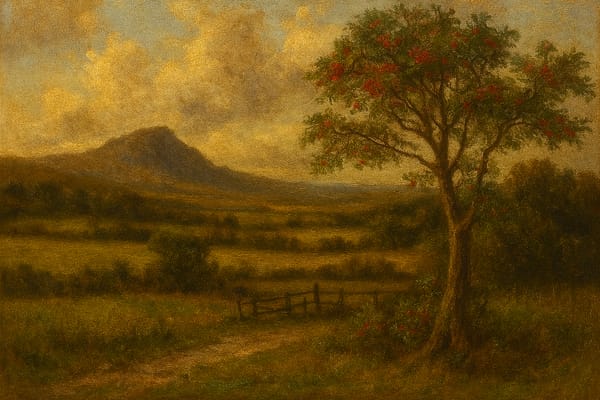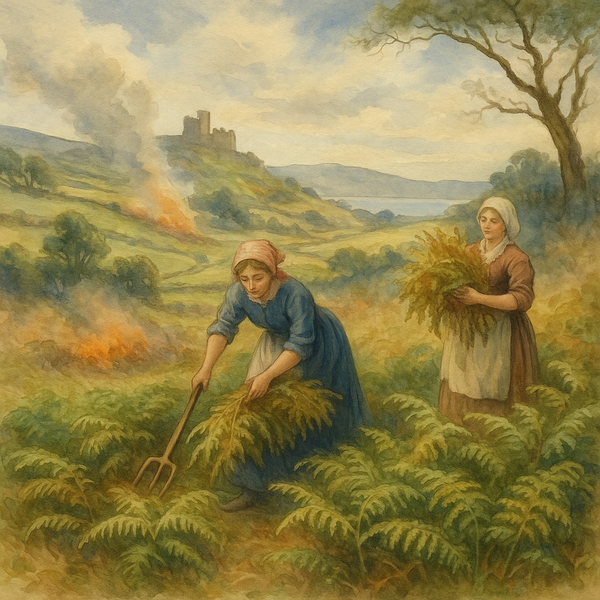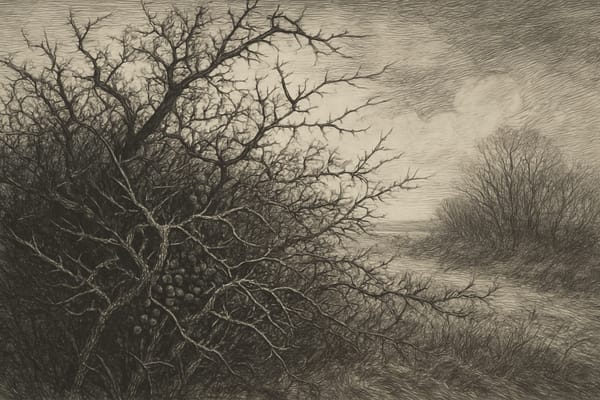Amid Cornwall’s windswept moors and sheltered valleys, few trees have woven themselves so deeply into the tapestry of folklore as the rowan. Known in Cornish tradition as a sentinel against dark forces, a companion for wanderers, and a sacred guardian of the thresholds between worlds, the rowan (Sorbus aucuparia) stands as a living link between nature, magic, and memory.
The Tree of Protection
For centuries, the rowan was planted near Cornish homes, farmyards, and sacred sites—not for beauty alone, but as a shield against the malevolent and unseen. With its vivid red berries and delicate five-pointed star marking at the base of each fruit, the tree carried natural symbols of protection. Red, long believed to repel evil, lent the rowan an almost talismanic quality.
In cottages and byres across Cornwall, charms made of rowan twigs—often fashioned into equal-armed crosses and bound with red thread—were hung over doorways and barn entrances. The rhyme whispered by generations, “Rowan tree and red thread, make the witches tine their speed,” echoed a belief in the tree’s power to slow or banish harmful enchantments. It wasn’t just homes that were protected. Livestock wore rowan sprigs on collars or tails during vulnerable times such as calving or lambing, a silent, natural safeguard against bewitchment.
A Tree of Thresholds and the Otherworld
In Cornish legend, the rowan was much more than a charm against ill fortune. It marked the thin places—the boundary between the seen and unseen worlds. Lone rowans standing at crossroads, near ancient stones, or by burial grounds were viewed as silent guardians of sacred ground. These places hummed with a sense of the otherworld, where the fae might wander or spirits stir.
Travellers carried rowan for protection against enchantment or to avoid becoming lost in the mists of Cornwall’s rugged landscapes. Walking sticks fashioned from its slender wood became companions on uncertain paths, believed to offer both direction and defense against mischief from the unseen.
Ritual and Celebration
The role of the rowan in Cornwall’s seasonal rhythms echoed its protective power. During May Day festivities, twigs and garlands of rowan adorned doors and windows, woven into crowns, or worn as amulets. These customs celebrated renewal and safeguarded the household against the unpredictable forces of the turning year.
Even in folk medicine, rowan’s reputation lingered—its berries used in protective charms, its wood burned in hearths during rites of blessing or warding off sickness. In times of trouble, it was not uncommon for families to visit a known rowan tree, circling it or offering tokens to ensure its guardianship.
Taboos and Timeless Respect
Rowan’s power came with a rule: it was never to be harmed. Cutting down a rowan, particularly a lone specimen or one near a sacred site, invited misfortune—or worse. These taboos were not idle superstitions but reflected a deep-rooted cultural respect for the balance between people, nature, and the unseen forces believed to dwell within Cornwall’s landscapes.
Even today, walkers and farmers might pause by an ancient rowan, acknowledging its silent watch over the land.
Rowan’s Legacy in Modern Cornwall
In an age that often feels disconnected from the land’s deeper stories, the folklore of the rowan continues to offer relevance. Its role as a protective symbol lends itself to modern community planting projects, rewilding efforts, and cultural celebrations. Rowan remains a key native species in biodiversity corridors and a beacon for conservation—bridging the gap between heritage and ecological health.
In gardens, hedgerows, and community spaces, planting a rowan carries forward not just a commitment to biodiversity, but a living connection to Cornwall’s story of respect, reverence, and belonging.











